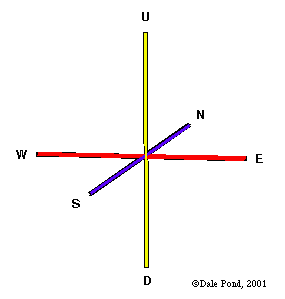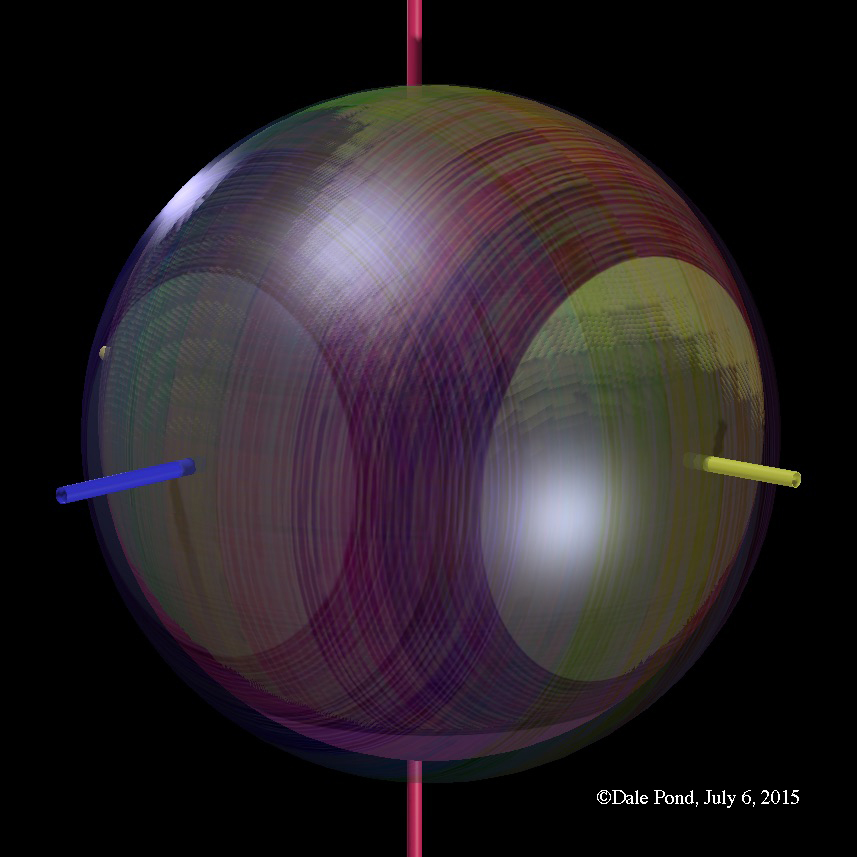In order that matter may exist (a three dimensional structure) there must be three dimensions. These directions or orientations are by convention and for ease of use: up/down, north/south and east/west. These directions or orientations are implied from The Beginning of materiality. These directions may be drawn as three lines intersecting at 90 degrees to each other. Within this three dimensional framework are inherent any number of other dimensions. In the SVP context these other dimensions are held to be ranges, subdivisions or planes of different frequencies as shown in Figure 1.3 and their consequential attributes. These are held to be nine in number and represent the nine types and/or energy or frequency ranges of Matter and Energy. Russell presented eighteen additional dimensions of matter which can be seen in 12.11 - Eighteen Attributes or Dimensions. The writer considers these to be more like "attributes" than true dimensions but we will use Russell's designation, dimension.

Figure 4.1 - Triple Cardinal Directions, Vectors or Dimensions
(click to enlarge)
See Also
cardinal number
cardinal point
Center
Energy
Entropy
Force
Neutral Center
Syntropy

Meanwhile Russell presented a different perspective on directions within his context of generative forces and radiative energies. There are many very good reasons for this which will be understood when we acknowledge inward forces (universal assimilation/attraction) is towards the centers of activities - much as sailors use the Pole (North) Star as a guide to their naval activities. All aspects of a rotating body are aligned to its Neutral Center which designates, controls and dominates all attributes of the body.
Figure 4.2 - Russell Directions of Power Accumulation (to North or Center) and Dispersion (to South or Radiation)
(courtesy of University of Science and Philosophy)
(click to enlarge)
See Also
3.04 - Power Accumulation via Fibonacci-like Patterns
accumulation
Accumulator
Dispersion
Electrical Power Accumulators
Exchanging Time for Power at Center or North
Figure 3.7 - Accumulating to Center on Three Planes
Figure 3.10 - Temperature Accumulates in the North and Cools in the South Reciprocally
Figure 3.12 - Force Accumulates from South to North
Law of Accumulation
Orgone Accumulator
Polar and depolar intermittent accumulator
Power multiplication
Scatterer
See Also
4.3 - Three Planes and Six Directions
4.8 - Centripetal Orthogonal Motions
angles of 90 degrees
Figure 10.05 - Three Orthogonal Planes where Six Gyroscopic Vortices Converge
Figure 3.13 - Orthogonal Vector Potentials
Figure 3.3 - Orthogonal Structure and Dynamics
Figure 3.7 - Accumulating to Center on Three Planes
Figure 4.10 - Pulsating to and from Centers Orthogonally
Figure 4.11 - Six Planes and Three Shafts Coincide to Produce Spheres
Figure 4.4 - Triple Vectors in Orthogonal Motions
Figure 4.6 - Triple Vectors in Motion on Triple Planes
Figure 4.7 - Triple Planes and Polar Vectors of Motion
Figure 4.9 - Pulsating to and from Centers Orthogonally
Figure 5.4 - Vortex and Gyroscopic Motion on One Plane then on three forming Sphere
Figure 5.7 - Vortices on Three Planes 90 Degrees to Each Other
Figure 6.1 - Orthogonal Vortex Motion as Structural base of Cubes
Figure 6.3 - Cube with Orthogonal Vectors
Figure 6.4 - Triple Interior Planes
Figure 6.5 - Triple Planes - May Underlay some Sacred Geometry or Religious Concepts
Figure 7.3 - Step 3 - Sphere Forms Orthogonally Triple Compressing Shell Layers
Figure 7B.15 - Triple Planes relative to Center
Figures 3.31 - Vortex Orthogonal and self-contained Motions - Structure
Figures 3.32 - Vortex orthogonal and self-contained motions - cross-section
Light Rings formed at 90 Degrees to Magnetic Center Line
Part 04 - Rotation on Three Planes
Part 05 - Three Rotating Planes Become Spheres
plane of 90 degrees
Rings
triple inertia planes
Triple Planes
Vector
Vector Field
